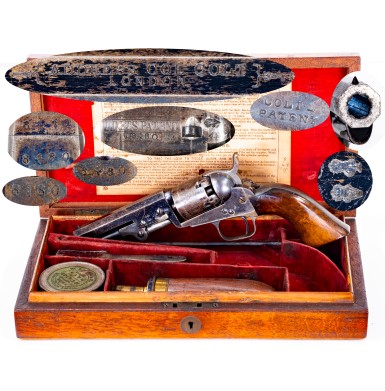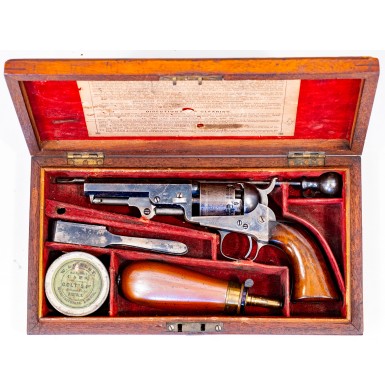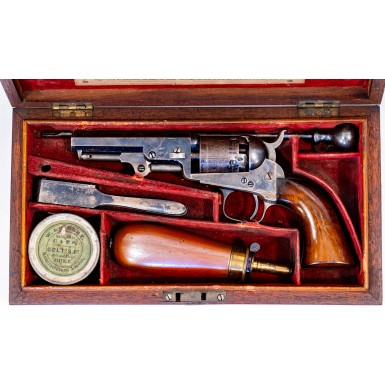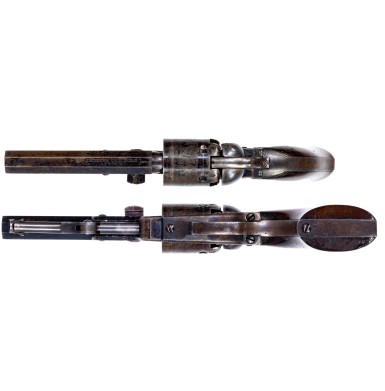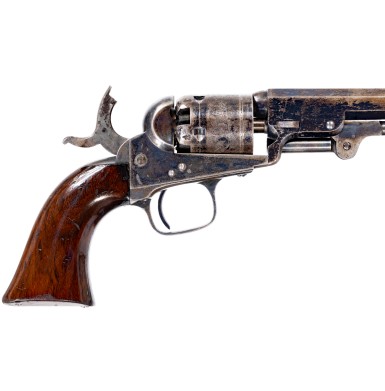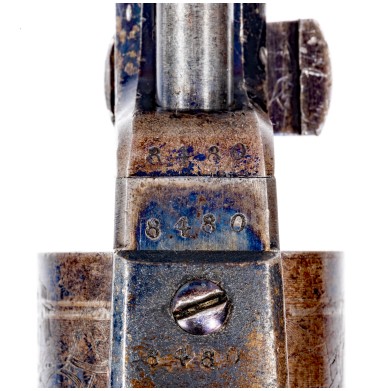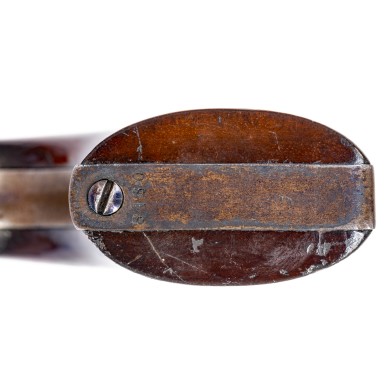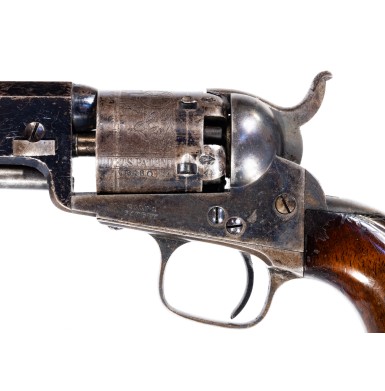Fine Cased Colt London Model 1849 Pocket Revolver
- Product Code: FHG-3C54
- Availability: Out Of Stock
-
$0.00
The Colt Model 1849 Pocket Revolver was the most successful percussion handgun ever produced by Colt, with more than 325,000 being manufactured in the United States between 1850 and 1873, and another 11,000 or so being produced at Colt’s short-lived London manufactory. The 1849 Pocket was an improved version of the Model 1848 Pocket Revolver, better known to collectors as the “Baby Dragoon”, which had first been introduced in 1847 and remained in production through 1850, when the Model 1849 Pocket Revolver superseded it. The “Baby Dragoon” had found a ready market among those who were taking part in the rapid westward expansion of the United States and were prized possessions in the California gold fields of the 1849 Gold Rush. The relatively short barrel (typically 3” to 6”), the compact five-shot cylinder (later production guns offered a six-shot cylinder) and the small .31 caliber chambering all combined to make a relatively light weight (around 22 ounces or 1 pound 6 ounces with a 5” barrel) and compact revolver that could be carried covertly in a jacket or trouser pocket. The “Baby” did have some drawbacks, the most obvious being the lack of an attached loading lever on the majority of the production. The other issue was the square backed triggerguard, which could be caught on the edge of a pocket when the gun was pulled from hiding. The improved version, the Model 1849 Pocket included a loading lever on all but the shortest barreled versions and a rounded trigger guard. Other changes from the early production “Baby Dragoons” that were standard on the 1849 had appeared as improvements on later Model 1848s and included an improved action with a roller on the bottom of the hammer, grease grooves on the cylinder arbor pin, and rectangular cylinder stop slots with a rounded concave profile along their leading edge. This improvement, which had been patented by Colt in 1850, was incorporated in all of their future percussion revolver designs and is still a feature found on nearly every revolver in production today. The 1849 Pocket also incorporated the roll engraved “Stagecoach Hold Up” cylinder scene that had been introduced during the latter part of Baby Dragoon production.
The Colt Pocket went into production in 1850, concurrently with the Baby Dragoon, and both models continued in production for some months utilizing the same serial number range. This means that early 1850 revolver production (which started around serial number 12,000) contained a mixture of “Baby” and “Pocket” revolver numbers overlapping within the same series, with the “Pocket” finally becoming the only handgun in that serial number range towards the end of 1850 (somewhere in serial number range of 14,000-15,000). The Colt Model 1849 Pocket was produced in more variations than any other Colt revolver and it is generally estimated that a collection of about two hundred Model 1849s would be necessary to cover all of the primary variants.
Due to the wide variety of features available, a “standard” Model 1849 is hard to define, but in general a typical Colt Pocket Revolver was a 5 or 6 shot .31 caliber single action percussion revolver with an octagonal barrel that was typically 3”, 4”, 5” or 6” in length, usually with an attached loading lever. During the latter part of production, particularly during the production of the “one-line New York address” guns, 4” barrels appear to have been standard with 5” and 6” guns less common and 3” guns no longer offered. The backstrap, gripstrap and triggerguard were usually of silver-plated brass, although this went away towards the end of production. The revolver was typically blued with a color case hardened frame, hammer and loading lever. Standard grips were varnished one-piece walnut. The revolvers were, however, available with a dizzying array of finishes, barrel lengths, grip options, and engraving. A dovetailed blade front sight was even a factory available option.
The London produced guns that were manufactured circa 1853 to 1856. Slightly less than 11,000 guns were “produced” at the London manufactory, with at least one reliable source citing a total of 10,755 guns being produced. The earliest “London” Colt Pockets were produced in the Hartford factory, however very quickly the London factory started to assemble guns from American made parts. Research indicates that the first London Colt Pockets that were completely produced in London, from parts made in the London factory, were not available until February of 1854. During the ramp up to full English production, some of the guns were produced with a mixture of English and American made parts, making for some interesting variants in the lower serial number range of London Colt Pockets. These guns typically appear below serial number 250, although some American made parts do appear in guns as high as serial number 1,000. Interestingly, towards the end of London production, some American made parts do appear in the manufacture of guns, typically in guns above the 8,900 serial number range through the end of production.
The London produced guns did have some differences from the Hartford produced guns. Most of the London guns were produced with iron triggerguards and backstraps rather than brass, and with screws that had more rounded and domed heads than their American counterparts. While the American pistols were available with a large number of finish and grip options, their London counterparts were almost universally produced with blued barrels and color case hardened frames and with varnished walnut grips. Many of the iron backstraps and triggerguards were silver plated, however the silver did not adhere well to the metal, so the silver is rarely encountered on pistols today. In some cases, these iron parts were simply blued. Most researchers feel that the market pressures in Great Britain forced Colt to produce his London made guns to a higher level of fit and finish than he did in America. This was necessary to compete with the large English handgun makers like Adams, Tranter and Webley, who typically produced revolvers of exceptional quality. The quality of the blued finish on the London guns was clearly superior to that on the American made guns, with the case hardening having a much bluer appearance than the American made guns and with less vivid coloration in the mottling.
Offered here is a lovely Cased London Colt Model 1849 Pocket Revolver. It is a classic London-made Pocket with the serial number 8480, indicating it was produced circa late-1855, the next to last year of production at the London facility. The gun as the two line, bracketed London address that reads:
{ADDRESS COL: COLT}
LONDON.
The revolver remains in FINE condition and is all matching, including the wedge. The cylinder has the usual COLT’S PATENT mark over the No 8480. A factory error occurred when stamping the cylinder as originally the number struck was “8080” but it was corrected and a “4” was stamped over the first “0”. The lower left of the frame has the usual small COLT’S/PATENT mark, and the serial numbers are typical “London style” numbers, with a smaller size and different font than found on the Hartford-made guns. As would be expected, the gun has London commercial proof marks on the left side of the barrel web, as well as between the five chambers of the cylinder. As would be expected, the London gun has the iron backstrap and triggerguard that is typical of London produced revolvers. These parts are blued and not silver plated, and London triggerguard that has the boxier profile, more squared with rounded edges, than US-made Colt Pockets.
This London-made gun is in FINE condition and retains much of the nice bright English blue on the barrel, around 35%+, with most of the loss due to flaking. The exposed areas have a dull, brownish gray patina. The metal is smooth with clear markings and shows no real pitting other than at the face of the muzzle. The metal shows only some scattered, lightly freckled surface oxidation and some tiny areas of pinpricking here and there. The backstrap and triggerguard retain only traces of their blued finish with a mostly brownish-blue patina. The frame retains about 70%+ of its vivid English color casehardened finish. The colors are the typical rich blues of the English finished Colt revolvers. The loading lever retains about 30%+ of its case coloring, mostly on the web with the balance having dulled and faded to a smooth bluish-gray patina. Some of the small parts like the trigger and screws retain nice amounts of their nearly luminescent niter blued finish. The revolver retains nearly all of its roll engraved cylinder scene, which is vividly apparent and deeply cut. The revolver is mechanically excellent and tight with a good bore with strong rifling that shows some scattered oxidation and light pitting. The one-piece varnished walnut grip is in about FINE condition as well. It retains most of the finish and shows some light handling wear, some finish loss and scattered bumps, dings and mars. The grip is solid and free of any breaks or repairs. The English grip is a lighter toned brown, tending towards yellowish or orange, than the darker brown American walnut used on the Hartford-made guns.
The revolver is contained in a VERY GOOD condition English Colt retailer oak casing that is fully compartmentalized and lined with a dark red baize cloth. The casing contains a number of accessories and accoutrements for the guns. These include a flask, mold, percussion caps, and cleaning rod. Unfortunately, the L-shaped combination tool is missing from the casing. All of these are in very good to fine condition.
The flask is an English-made pocket-sized flask that is marked on the top in three lines James Dixon/& Sons/Sheffield. The flask has an adjustable charging spout and remains in about FINE condition with some wear and scattered finish loss. The mold is an original .31 caliber blued iron dual cavity mold that is marked Colt’s/Patent on the sprue cutter. The mold is also FINE and retains some of its blued finish with very nice cavities. A correct style London cleaning rod is in the casing along the rear edge, with a blued steel head. The rod is in FINE condition as well. Finally, an empty large sized japanned steel cap tin with a green paper W.&C. Eley label is included in the case. This remains in about VERY GOOD condition with moderate wear and loss to the finish and the paper label.
As noted, the oak casing remains in about VERY GOOD condition. The exterior shows moderate wear with scattered bumps, dings and mars. The stained oak case is somewhat darker than some of the other English cases of the period and is very attractive, looking more like a Hartford mahogany veneer case, in terms of coloration. The lid has warped slightly but is not uncommon for these oak casings. The lid is also missing the brass escutcheon plate that could have had an owner's name, initials or coat of arms engraved on it. The original bible-hinges remain in place and are still sturdy, although one hinge plate is missing a screw. The red baize lining shows some moderate wear and minor loss, as well as some fading and staining but remains in overall good condition for its age
Overall, this is a really nice and very attractive Case London Colt Model 1849 Pocket Revolver. The casing is mostly complete and displays very nicely and the gun is extremely attractive with lots of finish, particularly case coloring on the frame. This will be a nice addition to any collection of percussion Colts, particularly one that centers around the London-made guns. It would also be a nice addition to a mid-19th century collection of English revolvers and would be right at home displayed with cased Adams, Tranter and Webley revolvers.
Tags: Fine, Cased, Colt, London, Model, 1849, Pocket, Revolver

